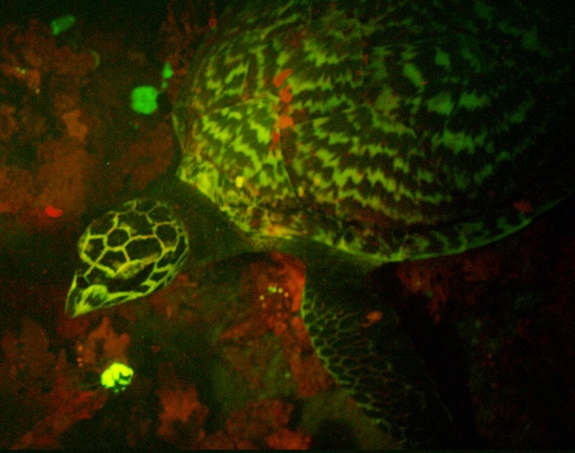
When the team of marine biologists led by David Gruber of the City University of New York headed to Solomon Islands in the South Pacific in late July, they were hoping to film some biofluorescent sharks and coral reefs. What they had never expected to find was the world's first-known biofluorescent reptile.
Gruber, who released the video and images of the 'glowing' turtle on September 28, says the encounter happened during a night swim. The researchers were in the middle of filming when they suddenly noticed a beautiful fluorescent turtle that resembled an "alien (space)craft with a patchwork of neon green and red all over its head and body."

Identified as the hawksbill sea turtle, it is the first known reptile to exhibit biofluorescence - the ability to absorb light, transform it and then emit it as a different color. This is different from bioluminescent animals that produce their own light through unique chemical reactions or by hosting light-transmitting bacteria.
While researchers have recently discovered some biofluorescent fish, sharks, rays and even tiny crustaceans, they had never seen a marine reptile with the capability. According to Gruber, the ocean provides the perfect environment to evolve these kinds of fluorescent molecules. The researcher says "The ocean absorbs almost every other color except for blue -- so these animals have been creating ways to take in that blue light and transform into other colors." The most common transformations are green, red and orange.

Gruber says he followed the beautiful reptile for a few minutes before it disappeared into the deep dark depths of the ocean. While the team did not encounter any more hawksbill sea turtles in the water, they did get an opportunity to examine a few captive specimens up close and observe them turning red.
The marine biologist says this discovery has left him with more questions than answers. He wants to know if the turtle can see its own glow. He is also curious if the biofluorescence is caused by certain chemical compounds in the reptile's diet or if the marine animal has the capability of producing the compounds on its own.
Researchers are not sure why the hawksbill sea turtle and other marine animals have developed this skill. They speculate that it could be a defense mechanism or a clever way to find and attract prey. In some cases, it could also be a way to communicate.

Alexander Gao, director of the Eastern Pacific Hawksbill Initiative, who has been studying the turtles for many years, believes in the turtle's case it may be a kind of camouflage.
Unfortunately, the team will not be able to research the hawksbill sea turtle to help solve the mysteries. That's because the gorgeous reptiles that have been incessantly hunted down for their decorative shells are currently on the critically endangered list. Gruber says that instead, he will try to get the answers from the marine reptile's closest relative, the green sea turtle, that also happens to be endangered, just not critically!
Resources: nationalgeographic.com,cnn.com, washingtonpost.com